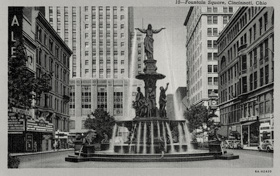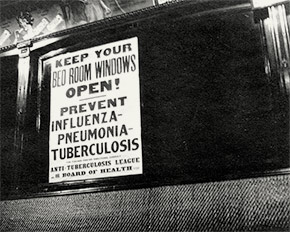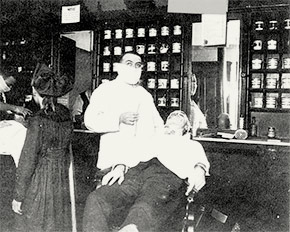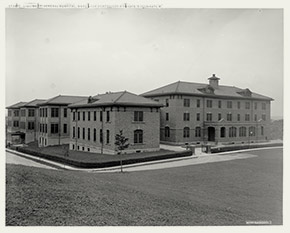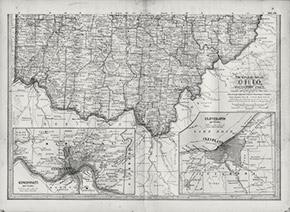Produced by the University of Michigan Center for the History of Medicine and Michigan Publishing, University of Michigan Library
Influenza Encyclopedia
The American Influenza Epidemic of 1918-1919:
A Digital Encyclopedia
Cincinnati, Ohio
50 U.S. Cities & Their Stories
Cincinnati newspapers very early began reporting on the appearance of influenza in the United States. On September 11, the Cincinnati Enquirer reported that an influenza outbreak had started in Boston in the last week of August and was making its way down and across the East Coast. The paper also reported on Surgeon General Dr. Rupert Blue’s list of symptoms and treatments for influenza, giving Cincinnati residents ample warning of the disease and the likelihood of it arriving in southern Ohio in the coming weeks. Surprisingly, however, the Enquirer noted that at its worst, influenza caused discomfort for only a few days.1 Unfortunately, Cincinnati residents were soon to find out the truth: epidemic influenza could be a terrible killer.
The first measure Cincinnati Health Officer Dr. William H. Peters took to protect his city from influenza was to order all visitors to hospitals barred except those calling on critical cases. Hospitals went even further, requiring those few visitors to wear a gauze mask, to be accompanied by a nurse, and to be disinfected after their visit. As of yet the daily case reports were still low–only 16 had been reported on October 3, the day Health Officer Peters announced the hospital measures, although one of the earliest cases had already resulted in death. Peters strongly cautioned Cincinnati residents to refrain from visiting soldiers at Camp Sherman in Chillicothe (100 miles to the west), and recommended that they also stay away from theaters, movie houses, and public meetings. He told residents that there was no undue cause for alarm and claimed that there was no epidemic as of yet in the city.2
Health Officer Peters quickly changed his mind about the seriousness of the situation. On Saturday, October 5, he met with Mayor John Galvin, the Board of Health, representatives from the Board of Education, the University of Cincinnati, the city’s General Hospital, and the Liberty Loan Committee, and theatrical managers and movie house owners to discuss the growing epidemic in Cincinnati. Peters estimated that there were some 4,000 cases of influenza in the city (although only 15 had been officially reported to the Health Department) and added that this number would likely grow quickly. Meeting attendees unanimously decided that Cincinnati should not wait until the disease was epidemic before taking action and threw their support behind a closure order, which the Board of Health immediately issued. Effective at midnight that day, all schools (public, private, and parochial), theaters, movie houses, churches and Sunday schools were ordered closed, and all public or private meetings either indoors or outdoors were prohibited. Saloons were not included in the order, the Board taking the position that a distinction could not be made between restaurants and saloons. Two days later, however, the Board modified the order: saloons could remain open, but liquor had to be sold in bottles and consumed off-premises. Representatives of the theater managers asked that their businesses be allowed to remain open on Sunday, October 6 so that they could conclude their weekly performances. The Board of Health relented.3
Health Officer Peters and Mayor Galvin were quick to point out that the city was not in the midst of a public health crisis. “Cincinnati is endeavoring to prevent an epidemic of Spanish influenza,” Mayor Galvin told the press. “There is no epidemic here. We are doing what other cities should have done–we are preventing.”4 Peters told the public that there was little to worry about, since influenza made seasonal appearances every year. He was not sure why more people were dying this year from influenza than normal. Perhaps, he said, susceptibility was high because of worry, fatigue, and conditions brought on by the war that tended to lower resistance. Whatever the cause, he added, “people should not become panicky.”5
As residents settled into new patterns of life without forms of public entertainment, city authorities still had no accurate gauge of how bad or good the epidemic situation actually was. On October 10, Health Officer Peters estimated that there were between 4,000 and 4,500 cases in the city, most of which, he believed, were in the convalescent stage. He also claimed that the epidemic had been checked, but added that he and other city officials would remain vigilant in their battle against influenza until it was stamped out completely. Two days later, Peters was supremely confident that “the spread of the disease had been checked definitely,” and that the closure order had “saved hundreds of lives in Cincinnati” in the few days it had been in place. He warned residents to remain vigilant so that influenza could be completely stamped out, telling them that if they did so the epidemic would be over within ten days.6
By October 14, however, Health Officer Peters was no longer feeling so optimistic. Case and fatality reports from the previous day showed the highest death rate since the start of the epidemic. Peters attributed this increase not to the natural lag between a rise in cases and a rise in deaths but rather to the burning of leaves, claiming that the smoke from recent leaf burning had caused the increase. He immediately issued a ban on the burning of leaves, telling residents that stricter measures were necessary now that the city “has reached the critical period in its fight against influenza.”7 Had he more closely examined reports of the epidemic on the East Coast, Peters would have understood that situation in Cincinnati was likely to grow much worse in the coming days. Indeed, the death rate in Cincinnati continued to climb after October 14, and would not reach its peak for another two weeks.
The next day, Peters himself fell ill with influenza. Newspapers reported his condition as “not serious,” and he was expected to make a short and full recovery in a few days. In the meantime, his assistant, Dr. Oscar Craven, assumed charge of the city’s Department of Health.8 Craven’s first order was to have hotels remove chairs and sofas from their lobbies and parlor floors to prevent lingering and crowding. He told hotel managers that guests could only remain in the public areas of hotels in order to transact business, not to loiter.9 When numerous saloons were found violating the bottle-only provision, Craven had the police redouble their efforts to keep drinkers from remaining on the premises. He made it clear that if saloons continued to violate the order, they would be closed.10 To the city’s residents, he advised a restful evening at home on Saturday rather than going out, a long walk on Sunday, and another good night’s sleep in preparation for the work week. To barbers and downtown hotel employees, he suggested wearing a mask. That regimen, he said, “will help in the fight to stamp out influenza.”11
By the last week of October, Cincinnati seemed to be rounding the bend. New cases and deaths began to decline. Fully aware that the danger had not yet completely passed but hopeful that the worst was over, city officials turned their attention to providing care and services to survivors. Families were asked to take in children who were left temporarily orphaned by ill parents. Penny lunch rooms were opened in the now-empty public school buildings so that families affected by influenza could get hot meals; more community kitchens were planned for the coming days. The Woman’s City Club was asked to send volunteers to answer emergency calls. The Health Department even arranged for volunteers to give convalescent victims car rides in the fresh air of the country. The volunteer spirit went so far that some two hundred residents, told that dust and other particulates were a major factor in the spread of influenza, assisted the Street Cleaning Department in flushing the streets. Officials believed it was such a success that the City Council transferred an additional $2,000 to the Street Cleaning Department to purchase new hoses for all the volunteers to use.12
Suddenly, however, health officials sounded the alarm about the dire influenza situation in Cincinnati. Within a few days of announcing that case and death numbers were decreasing, Peters, now recovered from his bout with influenza, told the press that the in fact the epidemic was continuing unabated. On October 27 he estimated the total number of cases since the beginning of the epidemic at a staggering 20,000–25,000, and added that the number was increasing daily. The very next day, Peters changed his mind and reported that new case tallies were declining. The day after that, on October 29, the Superintendent Walter List of the city’s General Hospital told reporters, “the influenza situation in Cincinnati is precarious.” He stated that there was no decline in either the number of new cases or in the death rate. Yet, when explaining that calls for volunteer nurses largely had fallen on deaf ears because people were afraid of contracting influenza, List claimed that there was little danger, since “practically everyone in Cincinnati has been exposed to the disease.” Anna Burgess, a nurse at List’s General Hospital who contracted influenza and died, would have strongly disagreed. Superintendent List then argued that saloons and five-and-dime stores should be closed as a further precautionary measure against the epidemic, which, presumably, was no longer a threat because the vast majority of city residents had been exposed and thus inoculated. Health Officer Peters, in a break from his previous stance, seemed to be of an opposite mind about the need to tighten public health measures, and was expected to go before the Board of Health the following day to ask that churches be permitted to re-open and that sporting events such as football games be allowed.13 No one, it seemed, had a clear idea of just how good or bad Cincinnati’s influenza situation actually was, nor did anyone know what measures were likely to produce the best effects.
On October 30, the Board of Health met to discuss the recent slate of appeals that had been made to allow for a partial removal of the closure order measure. A committee of clergymen asked the Board to allow churches to re-open, arguing that churches could help fight the epidemic by consoling those who were “sorely distressed” and by “sustaining the morals of the people” in their time of need. When it became clear that the Board was not going to be swayed by such arguments, the clergymen asked that they be allowed to open their side doors to “transient worshippers,” which the Board likewise rejected. Appeals from the zoo and from the Queen City Club were likewise rejected. The Cincinnati Symphony Orchestra was told to hold off on rehearsal planning for the next week, and the War Chest Committee was advised not to plan meetings until further notice. Some organizations, such as the local Draft Board, the Civil Service Commission, and the Board of Elections were given special dispensations because of their functions. Everyone else was told that there would be no relaxing of the closure order or gathering ban, although the Board hinted that the restrictions might be removed in a week’s time if the epidemic situation improved sufficiently. In the meantime, the Board of Health actually tightened the restrictions slightly, ordering all retail shops to close by 5:30 pm and–in a move that again betrayed the prevailing belief in fomites as spreaders of influenza among Cincinnati’s medical and public health community–prohibited the selling or purchasing of second-hand clothes.14
As October turned into November, Peters once again announced that the epidemic’s end was near. After reading new case reports and interviewing physicians from all sections of the city, Peters announced he was confident that the epidemic was on the decline, and that it would be over within the next seven to ten days so long as the public remained vigilant. The number of deaths would not begin to decrease during that period, he cautioned, due to the large numbers of cases currently under treatment. Still, Peters, and even Superintendent List, were for the first time truly confident that the peak of the epidemic had passed.15
Their conclusion was borne out in the coming days, as the daily reports indicated. By now, Cincinnati’s epidemic was four weeks old. During that time, 4,625 residents had fallen ill with influenza, 681 of them dying as a result.16 Over the course of the next week, those numbers naturally increased, but they did so at a much slower rate than they had previously. Health Officer Peters and the Board of Health still refused to lift the restrictions, however, despite a nearly daily barrage of appeals and numerous rumors predicting their impending end. They wanted to be sure that the epidemic really was over. Finally, on November 11–Armistice Day–the Cincinnati Board of Health agreed to lift all anti-influenza restrictions effective at midnight. As Mayor Galvin summed it up, “The people are tired of hearing of influenza and want to forget it. The psychological time for raising the restrictions has arrived. You can no more control the people’s enthusiasm nor regulate their actions on the street than you can control the Ohio River.”17 No doubt the residents of Cincinnati agreed wholeheartedly.
Theaters, movie houses, churches, and schools re-opened. As was standard procedure in most cities that had closed schools, returning children were expected to be free from influenza. Those who had contracted the disease, who showed cold-like symptoms, or lived in homes where a family member had influenza, were not allowed to return to their classroom until six days after the fever had passed. But within a week or so after schools had re-opened, officials reported a sharp rise in the number of new cases among the city’s schoolchildren. The numbers steadily increased during the last week of the month, and by Thanksgiving over half of the new cases reported citywide to the Health Department were in children ages 3 to 14. School authorities added an extra day vacation to the Thanksgiving holiday break, hoping that this would slow or halt the epidemic’s increase. Fortunately, the majority of cases among children were mild, with relatively few of them developing pneumonia. Health Officer Peters and the Board of Health therefore saw no reason at the present to re-close all the city’s schools. Rather, he announced that individual schools would be closed if a large number of students contracted influenza.18
When students returned from Thanksgiving break, however, the situation suddenly became worse. Classrooms were much emptier, as 32% of the student body was absent–12% ill with influenza and an additional 20% kept at home by concerned parents. According to the Board of Education, daily absentee rates were normally approximately 8%. With the rise in cases among the city’s children, and with nearly a third of students absent, Health Officer Peters and the Board of Health had little option but to once again close all Cincinnati’s elementary and grammar schools effective December 2. High schools and the University of Cincinnati were to be closed if absentee rates due to illness reached 5% of total enrollment. Within a day, five of the six high schools in the city were closed; the sixth closed a few days later. After the Superintendent of the School District argued that it would be useless to close schools and not prevent children from congregating in other locations, the Board of Health augmented its new order: children under 16 years of age were barred from theaters, movie houses, Sunday schools, stores and shops, streetcars, public gatherings, and all places of amusement. So determined were Cincinnati officials to keep children out of public places that the City Council considered passing an ordinance making it a misdemeanor for parents to allow infected children to visit such places. It was, in effect, a targeted closure order aimed at the city’s young.19
Schoolchildren were not the only city residents hard hit by influenza. Cincinnati’s firemen, confined to cramped firehouses, suffered heavy losses during the first peak of the epidemic, and now were suffering once again. By the end of the first week in November, two entire companies of firefighters had to be abandoned temporarily after 139 of them fell ill to influenza.20 At the end of the month, after 21 more firemen developed influenza, stations were ordered to stop accepting used clothing for the white elephant rummage sale out of fear that the articles might be contaminated with influenza germs. Meanwhile, 21 civilians were posted to various firehouses to help there until the absent firemen recovered and returned to duty. That number would grow to 54 by December 5.21 The situation had grown so severe that Cincinnati asked the War Department for a loan of 69 soldier-firemen to help until the city’s firehouses were back up to strength. Unfortunately, the War Department felt it could not spare any personnel.22 General Hospital was said to be overwhelmed with the sheer number of firefighters alone in its wards. Sick firemen brought the disease home with them after their shifts, infecting their wives and children. By mid-December, several dozen wives and over 60 children of firefighters were down with influenza.23 All told, Cincinnati’s firefighters suffered a death rate of 23 per 1,000, compared to 9 per 1,000 for the city’s police force.24
Not everyone in Cincinnati was pleased with the Board of Health’s decision to avoid a second general closure order by instead targeting its measures at keeping children out of public places. Several residents wrote letters to the editor of the Cincinnati Enquirer complaining that Health Officer Peters and the Board of Health stupidly believed that influenza was discriminatory, attacking children rather than adults. Peters acidly replied that the criticism of his department was not constructive, and that he and the Board were using their best judgment in handling the situation.25 On December 6, that judgment resulted in the serious contemplation of a second general closure order after reports indicated a sharp rise in the number of new cases. This time, the closure order under consideration would be even more sweeping than the first. In addition to places of public gathering and amusement, the Board of Health was considering shutting down every business and factory in the city except those necessary to the sustenance of residents. Spokespeople from theaters, movie houses, churches and synagogues, saloons, and other places of amusement vigorously protested the exception to vital businesses. They argued that while they definitely would be closed, many businesses would be able to escape such a fate through this loophole. Even Mayor Galvin opposed such a sweeping order, although he believed the Board was comprised of men of wise counsel who would ultimately choose to do what was best for the city. The Board of Health would make their decision on Wednesday, December 12. Health Officer Peters, who no more wanted to shut down the city than did anyone else, requested that downtown retail stores close by 4:30 pm and urged residents to do their best to avoid crowds between now and then so that a total ban would not be necessary.26
When the Board met on December 12, Health Officer Peters again recommended regulating businesses hours and rather than a general closure order. He suggested a plan whereby stores in the downtown district would close by 4:30 pm, offices by 5:00 pm, wholesale establishments by 5:15 pm, and factories by 6:00 pm. Saloons would close by 7:00 pm, undoubtedly to the chagrin of after-work tipplers. Movie houses, Peters, suggested, should close between 4:15 pm and 6:00 pm to allow for full and proper ventilation. Although some members preferred shutting down the city entirely, the Board agreed to go along with Peters’ plan after he gave them encouraging reports of lower numbers of new cases from the past several days.27 Cincinnati was spared a second closure order.
Residents were pleased by the Board’s decision, but many businesses, rather surprisingly, were not. Saloon owners, for example, complained that they were required to close their doors by 7:00 pm while movie houses could continue to operate well into the night. Merchants complained that closing at 4:30 pm was too early, and wanted to extend their hours to at least 6:30 pm, arguing that such a move would help alleviate crowding on street cars and would allow them to make up for business lost during the epidemic. One haberdasher told his colleagues that they should all ignore the order and take the matter to court, where at least their voices would be heard.28
In the end, these protests became moot points when the Board of Health suddenly revoked its order only two days later. Meeting in special session on the afternoon of December 14, members quickly decided that the influenza situation in Cincinnati had improved enough over the course of the previous few days to warrant removal of the restrictions on business hours. Undoubtedly weighing on their minds were the numerous complaints they had received from concerned business owners, and the fact that most members fully realized that the board’s order was discriminatory and largely unenforceable.29
On December 23, the Board of Health removed the ban prohibiting children from entering public places. The next day, parochial schools re-opened. A week later, on Monday, December 30, Cincinnati’s public schools opened their doors again. Private schools, many of which held correspondence courses during the closure period, re-opened the following week. The ban on children entering public places was removed, and life in Cincinnati slowly returned to normal. The worst had passed.30
The Cincinnati Health Department estimated the total number of influenza cases during the fall of 1918 to be a whopping 100,000, most certainly an overestimate, as it would have meant a quarter of the population had fallen ill with the disease during the epidemic. Nevertheless, the city’s epidemic experience had been a harsh one, despite the early action of officials. Nearly 1,700 residents had died from the either influenza or pneumonia during the epidemic. The result was an excess death rate of 451 per 100,000 population, certainly better than the hardest-hit cities in the nation, but not nearly as good as either Columbus or Toledo, or even nearby Dayton or Louisville. Oddly, the disease seemed to attack two of the city’s less densely populated and wealthier wards (the Second and the Twentieth) with particular vigor, while two crowded wards with poor housing conditions (the Seventh and the Eighteenth) experienced very low mortality. As mentioned, the city’s 565-man fire fighting force seemed particularly singled out, forcing several fire stations to recruit untrained volunteers simply to remain open. Some 122 of Cincinnati’s youngsters under the age of 5 died of influenza, an ironic fate given that 1918 was supposed to be Children’s Year in the city. And in a city that prided itself on its industry and labor, the harsh reality that 64% of the epidemic deaths had occurred among people in their prime–“when human life is of the greatest economic importance,” as the Cincinnati Sanitary Bulletin put it–was an especially stinging blow.31
Notes
1 “Influenza Outbreak Grows,” Cincinnati Enquirer, 11 Sept. 1918, 3; “Appearance of Spanish Influenza is Noted at American Atlantic Coast Cities – Distressing but Not Serious,” Cincinnati Enquirer, 12 Sept. 1918, 14, and “Physicians Told How to Fight Influenza; Public Health Service to Combat Spread of Disease,” Cincinnati Enquirer, 14 Sept. 1918, 1.
2 “Visitors Barred from Hospitals,” Cincinnati Enquirer, 3 Oct. 1918, 11. The first influenza-related death in Cincinnati occurred on October 1. Cincinnati Sanitary Bulletin, 1916-1918 (Cincinnati: 1919).
3 “Influenza: An Inventory of the Local Situation,” Cincinnati Sanitary Bulletin 2 (Oct. 3, 1918), 1, “Meetings under Health Ban,” Cincinnati Enquirer, 6 Oct. 1918, 24, “Liquor to be in Bottles,” Cincinnati Enquirer, 8 Oct. 1918, 8, “Order of the Board of Health,” Cincinnati Sanitary Bulletin 2 (Oct. 10, 1918), 1.
4 “No Quarantine!” Cincinnati Enquirer, 7 Oct. 1918, 14.
5 “No Need for Alarm,” Cincinnati Enquirer, 8 Oct. 1918, 8.
6 “Seven Die of Spanish Influenza,” Cincinnati Enquirer, 10 Oct. 1918, 9, “Results of Closing Order Seen,” Cincinnati Enquirer, 13 Oct. 1918, 8.
7 “Crisis in Epidemic Is Reached,” Cincinnati Enquirer, 14 Oct. 1918, 4.
8 “Day’s Toll from Influenza is 32,” Cincinnati Enquirer, 16 Oct. 1918, 5.
9 “Victims of Malady Number 136,” Cincinnati Enquirer, 17 Oct. 1918, 14.
10 “Epidemic Spreads More Rapidly,” Cincinnati Enquirer, 19 Oct. 1918, 14.
11 “Death Toll from Influenza is 215,” Cincinnati Enquirer, 20 Oct. 1918, 12.
12 “Check on Influenza is Seen,” Cincinnati Enquirer, 22 Oct. 1918, 8, “Aids Epidemic Victims,” Cincinnati Enquirer, 22 Oct. 1918, 8, “Citizens to Help Flush Streets,” Cincinnati Enquirer, 23 Oct. 1918, 5.
13 “Disease Exacts Toll of Death,” Cincinnati Enquirer, 27 Oct. 1918, 16, “Ban on Shopping at Night,” Cincinnati Enquirer, 28 Oct. 1918, 14, “Problem is Faced at Hospital,” Cincinnati Enquirer, 29 Oct. 1918, 8.
14 “Stores Are Closed at 5:30 PM,” Cincinnati Enquirer, 31 Oct. 1918, 14.
15 “Outbreak of Influenza,” Cincinnati Enquirer, 1 Nov. 1918, 14.
16 “Crest of Epidemic,” Cincinnati Enquirer, 3 Nov. 1918, 20.
17 “It’s Off!,” Cincinnati Enquirer, 12 Nov. 1918, 8.
18 “Children Gripped by Influenza,” Cincinnati Enquirer, 26 Nov. 1918, 8, “Malady Stalks among Children,” Cincinnati Enquirer, 28 Nov. 1918, 8, “Spread of Influenza Epidemic,” Cincinnati Enquirer, 29 Nov. 1918, 11.S
19 “New Ban to Close Many Schools,” Cincinnati Enquirer, 3 Dec. 1918, 16, “Appeal for More Nurses Sent,” Cincinnati Enquirer, 4 Dec. 1918, 5.
20 “Keerful!,” Cincinnati Enquirer, 5 Nov. 1918, 8.
21 “Malady Stalks among Children,” Cincinnati Enquirer, 28 Nov. 1918, 8, “Flare up of Epidemic Indicated,” Cincinnati Enquirer, 30 Nov. 1918, 14.
22 “Survey of Malady in Schools,” Cincinnati Enquirer, 1 Dec. 1918, 10.
23 “Ventilating Systems,” Cincinnati Enquirer, 11 Dec. 1918, 9.
24 “Epidemic Influenza,” Cincinnati Sanitary Bulletin 2 (Jan. 10, 1919), 3.
25 “Suggestion Ridiculous,” Cincinnati Enquirer, 5 Dec. 1918, 14.
26 “Lid Order Affecting Whole City,” Cincinnati Enquirer, 7 Oct. 1918, 14, “Protest Voiced by Suburbanites,” Cincinnati Enquirer, 9 Dec. 1918, 12.
27 “Regulations for Business Adopted,” Cincinnati Enquirer, 12 Dec. 1918, 14.
28 “Decline Noted in Malady Cases,” Cincinnati Enquirer, 13 Dec. 1918, 4.
29 “Ban Rules Revoked by Board,” Cincinnati Enquirer, 15 Dec. 1918, 32.
30 “Restrictions on Children Are Off,” Cincinnati Enquirer, 24 Dec. 1918, 7, “Schools Reopen Today,” 30 Dec. 1918, 14.
31 “Epidemic Influenza,” Cincinnati Sanitary Bulletin 2 (Jan. 10, 1919), 4-5.
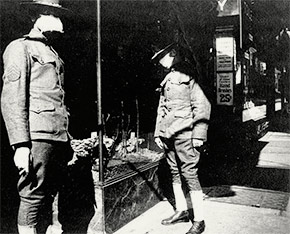 Click on image for gallery.
Soldiers from Camp Gordon, Georgia, passing through Cincinnati wearing flu masks. From the National Archives and Records Administration.
Click on image for gallery.
Soldiers from Camp Gordon, Georgia, passing through Cincinnati wearing flu masks. From the National Archives and Records Administration.
